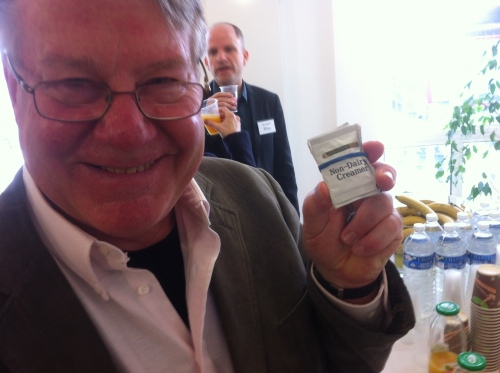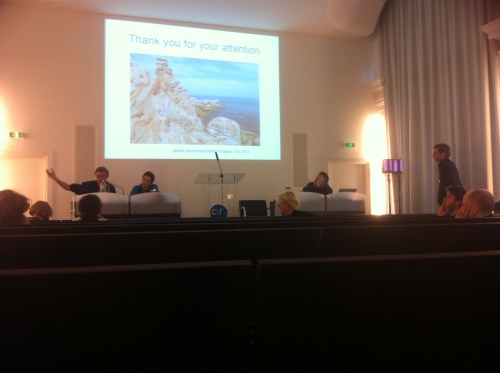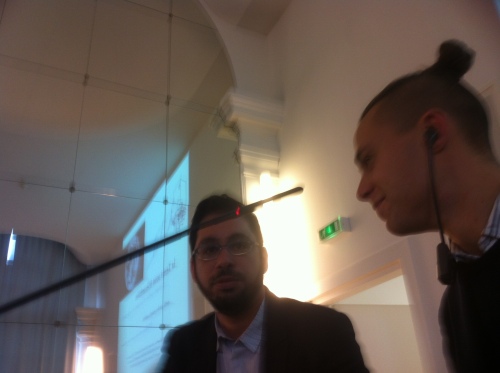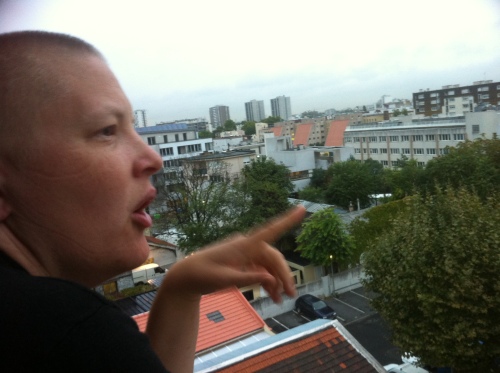From Paris With Love
At a parisian coffee table, I realise my Scandinavian habits about dairy products (in this case access to milk) had not been anticipated by french hosts. “Here”, Jim Fleming hands me one of his bags of powder-cream, “I always bring these when I go abroad”. Jim Fleming is a frequent friend and visitor of Scandinavia.
Paris was the venue for Sebastian Grevsmuhl’s conference on “Global Environmental Images”. Apart from my interest in remote sensing satellites, the general question asked was:
What technologies and imageries are involved when making environment ‘global’?
Mass media is one part of the equation. Finis Dunaway presented work from his upcoming book ‘Seeing Green’ where late 20th century media is full of corporate funding with a serious influence over how environmental issues are appropriated. Although the source material is a bit US-centric, it adds to studies of image meaning a material ground which I found compelling. Rather than just discussing aesthetics and cultural meanings of an image, it does matter that advertising firms had a clear role and mission in framing environment to be a question of individual responsibility and consumption, the clever combination of therapy and empowerment, instead of getting at structural problems more at the heart of environmental degradation.
The story of the environmentalism in media is then also the emotional history of capitalism, that while companies may cause problems we can solve it by populating the market with responsible consumers. Together these add up to a clever combination of therapy and empowerment, faith and market-solutions.
While Dunaway concluded that this rhetorical use of environment is prevalent also at present, e.g. Al Gore and ‘An Inconvenient Truth’, Richard Hamblyn made a push for optimism, that we should continue to turn to images as these stirred society towards action. Although a challenge of climate change is its imperceptibility, Hamblyn suggests we may have crossed the point of peak pessimism and are now beginning to understand how environment can be appropriated in order for us to act upon its and our continued existence.
“Remember this, everything simple is false, everything that is complex is unusable.”
I got from Hamblyn (citing Latour) that seeings starts where nature ends, we can simply not speak of environment in ways that have not be articulated according to human concerns. And furhermore, the issue is not whether how historical imagery have impeded us from acting sustainably; the larger story is that images have power over actions, period. What then follows is to formulate imagery interpretations that deal with images of concern for humanity. Sort of long for saying:
If industrialists are going to have the last word, then why are we here talking about this stuff?
Martin Mahony followed up on the importance of images, citing Peter Galison “The Map has become the territory”. We cannot reduce imagery appropriation as good science being destroyed by bad politics (or companies), but it is also about ideas of objectivity and that how the world is understood is inseparable from how we are concerned with living in it.
I think this is the reason why studies in technological systems are relevant for understanding what environment predicament, the territory, is. But a caveat here is that it is a history not only of how things are constructed but reconstructed as new elements must be appropriated as work goes on.
The global is not just about images, but the discourse these are thought to invoke or influence. How to get at the discourse? Follow words used, and changing etymology? Nicolas Baya-Laffite exemplified this by showing thematic shifts in words and topics prevalent in climate negotiations, i.e. words, not images, of environment and the global. Baya-Laffite and his colleagues had used proxys, the bulletins handed out day-by-day at IPCC-meetings, which portrayed “in the corridor”-discussions of climate negotiations. In terms of source tendency, this is excellent although the end result would “just” be an exposé of the rise and demise of words, themes and problem areas. But this descriptive account of the IPCC does serve to frame more qualitative, and speculative, studies of environmental debates. Also, an image of these discursive trends underlines the aphorism “An image says more than a thousand words”, precisely because Baya-Laffite’s image does include a thousand words, or more, and also serve as reminder for us to study the production process through which images were assembled.
We come then to the issue of narratives, which is where Jim Fleming made a point about expanding discussions of the Anthropocene to previous time periods in order to understand what has influenced present technocultures. One such is sci-fi, e.g. the author Arthur C Clarke in his influence on space development and in particular the satellite Tiros. The enterprise is two-fold:
1. the impact of technological infrastructure for our conception of environment at present
2. the influences on technoculture which put the technological infrastructure there in the first place
Fleming’s final remark, that “all good sci-fi have a moral core” is a reminder for what makes narratives, scientific or popular, able to inform society. On this last point I am reminded that one of the most influential parts of Grevsmuhl’s conference were meetings with people yet unmentioned.
And it would have been great to have seen more of Paris or hang out with Anna who was hosting me in the northeast near Courneuve (also the setting for La Haine). Ofcourse, This is stuff for future writing and collaboration. In all, I left Paris with love and a belief that narrativizing technological systems is part of giving the Anthropocene its moral core.




